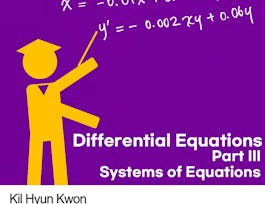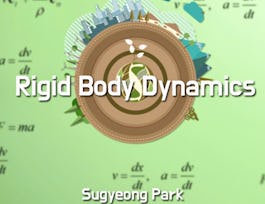This capstone course is the 3rd and final course of the specialization Advanced Spacecraft Dynamics and Control. It assumes you have completed the prior courses on "Attitude Control with Momentum Exchange Devices" and "Analytical Mechanics for Spacecraft Dynamics". This project course investigates the dynamics of a complex spacecraft system where there is a rigid hub onto which a hinged panel is attached. This simulates a spacecraft with a time varying geometry.



Advanced Capstone Spacecraft Dynamics and Control Project
This course is part of Advanced Spacecraft Dynamics and Control Specialization

Instructor: Hanspeter Schaub
Sponsored by Syrian Youth Assembly
Recommended experience
What you'll learn
How to create and validate a simulation of a spacecraft with a hinged panel.
Investigate spacecraft dynamics with a time varying geometry.
Skills you'll gain
Details to know

Add to your LinkedIn profile
6 assignments
See how employees at top companies are mastering in-demand skills

Build your subject-matter expertise
- Learn new concepts from industry experts
- Gain a foundational understanding of a subject or tool
- Develop job-relevant skills with hands-on projects
- Earn a shareable career certificate


Earn a career certificate
Add this credential to your LinkedIn profile, resume, or CV
Share it on social media and in your performance review

There are 3 modules in this course
Welcome to the capstone project of the course sequence on advanced spacecraft dynamics and control.
What's included
1 video
In this lesson we study a spacecraft system that contains a rigid hub with a hinged solar panel. Here the hub and panel center of mass locations are free to move relative to the spacecraft system center of mass. Fundamental properties of the dynamical description are derived.
What's included
1 reading3 assignments
In this module we develop the differential equations of motion of the hub-panel spacecraft system that is constrained to rotate about a single axis. Two different open-loop torque solutions are applied to reorient the spacecraft from rest to a new stationary attitude. The impact of filtering a classical bang-bang control solution is investigated by apply a first-order low-pass filter to the control input.
What's included
1 reading3 assignments
Instructor

Offered by
Why people choose Coursera for their career




Recommended if you're interested in Physical Science and Engineering

Michigan State University

ISAE-SUPAERO

Korea Advanced Institute of Science and Technology(KAIST)

Korea Advanced Institute of Science and Technology(KAIST)

Open new doors with Coursera Plus
Unlimited access to 10,000+ world-class courses, hands-on projects, and job-ready certificate programs - all included in your subscription
Advance your career with an online degree
Earn a degree from world-class universities - 100% online
Join over 3,400 global companies that choose Coursera for Business
Upskill your employees to excel in the digital economy


